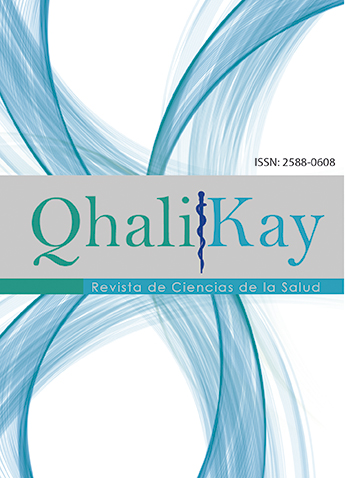Valor diagnóstico de la combinación de nueve marcadores tumorales en neoplasias
Diagnostic value of nine tumor markers combination in different malignancies
DOI:
https://doi.org/10.33936/qkrcs.v1i1.123Resumo
Muchos marcadores tumorales (MT) no son específicos a un tipo particular de cáncer y el nivel de uno de ellos puede aumentar como consecuencia de más de un tipo de cáncer, por lo que se utilizan en combinación para lograr mayor efectividad diagnóstica. Este trabajo se propone evaluar el valor diagnóstico de la combinación de nueve MT utilizados en diagnóstico de neoplasia tanto de forma individual como combinados. Se realizó un estudio retrospectivo entre enero 2013 y mayo de 2015 en el Laboratorio Clínico del Centro de Investigaciones Médico Quirúrgicas de La Habana a 100 pacientes con diagnóstico de cáncer o sospecha clínica de neoplasia oculta a quienes se les determinaron los marcadores tumorales: antígeno carbohidrato (CA) 19.9, CA 72.4, CA 125, CA 15.3, antígeno carcinoembrionario (CEA), componente de la citoqueratina 19 (Cyfra 21-1), gonadotropina coriónica (HCG), ferritina y antígeno prostático de superficie (PSA). En todos los MT se observó un incremento del valor de corte sobre el valor límite superior de referencia mayor al 8%. En conjunto, la sensibilidad, especificidad, valor predictivo positivo (VPP) y valor predictivo negativo fueron de 23%, 99%, 96% y 51%, respectivamente. Para un valor de corte de 50 la especificidad y el VPP aumentaron a 99,6% y 97,5%, respectivamente. El uso de los 9 marcadores tumorales en conjunto mostró ser útil en el proceso de diagnóstico de pacientes con enfermedad neoplásica.
Palabras clave: marcadores tumorales, CA 19.9, CA 72.4, CA 125, CA 15.3, CEA, Cyfra 21-1, HCG, Ferritina y PSA
Abstract:
Many tumor markers are not specific to a particular type of cancer and the level of one of them may increase as a result of more than one type of cancer, that’s why they are used in combination to achieve greater diagnostic effectiveness. This work aims to evaluate the diagnostic value of the combination of nine tumor markers commonly used in diagnosis of neoplasia both individually and in combination. A retrospective study from January 2013 to May 2015 was conducted at the Clinical Laboratory of the Center for Medical and Surgical Research in Havana, in 100 patients with cancer diagnosis or clinical suspicion of occult malignancy and to whom carbohydrate antigen (CA) 19.9, 72.4, CA 125, CA 15.3, carcinoembryonic antigen (CEA), component cytokeratin 19 (CYFRA 21-1), chorionic gonadotropin (HCG), ferritin and prostate surface antigen (PSA) tumor markers were identified. An increase of cutoff value above the upper limit reference value in all higher TM 8% was observed. Overall, the sensitivity, specificity, positive predictive value (PPV) and negative predictive value were 23 %, 99 %, 96 % and 51 %, respectively. For a cut value of 50 specificity and PPV, they increased to 99.6% and 97.5%, respectively. The use of 9 tumor markers together showed to be useful in the process of diagnosing patients with neoplastic disease.
Key words: tumor markers, CA 19.9, CA 72.4, CA 125, CA 15.3, CEA, Cyfra 21-1, HCG, Ferritina and PSA.
Downloads
Referências
2. Carvajal C-F, Morales M. Sensibilidad y especificidad de los marcadores tumorales. Rev Médica Cochabamba. 2010; 86. [Internet] 2010 [acceso: 10 de marzo de 2016] Disponible en: http://www. revistasbolivianas.org.bo/scielo.php?pid=S2074 6092010000100014&script=sci_arttext&tlng=en
3. Liu W, Yang J, Chi P-D, Zheng X, Dai S-Q, Chen H, et al. Evaluating the clinical significance of serum HE4 levels in lung cancer and pulmonary tuberculosis. Int J Tuberc Lung Dis. 2013 Oct;17(10):1346–1353.
4. Kong S-Y, Han MH, Yoo H-J, Hwang J-H, Lim M-C, Seo S-S, et al. Serum HE4 level is an independent prognostic factor in epithelial ovarian cancer. Ann Surg Oncol. 2012 May; 19(5):1707–1712.
5. Hertlein L, Stieber P, Kirschenhofer A, Krocker K, Nagel D, Lenhard M, et al. Human epididymis protein 4 (HE4) in benign and malignant diseases. Clin Chem Lab Med. 2012 Dec; 50(12):2181–2188.
6. Yamashita S, Tokuishi K, Moroga T, Yamamoto S, Ohbo K, Miyahara S, et al. Serum level of HE4 is closely associated with pulmonary adenocarcinoma progression. Tumour Biol J Int Soc Oncodevelopmental Biol Med. 2012 Dec; 33(6):2365–2370.
8. Molina R, Escudero J-M, Augé J-M, Filella X, Foj L, Torné A, et al. HE4 a novel tumour marker for ovarian cancer: comparison with CA 125 and ROMA algorithm in patients with gynaecological diseases. Tumour Biol. 2011 Dec; 32(6):1087–1095.
9. Campuzano-Maya G. Utilidad clínica de los marcadores tumorales. Medicina & Laboratorio 2010; 16:411-445.
10. Sánchez A. Valores de referencia o valores de corte clínico: ¿qué criterio tomar en el laboratorio clínico actual? Bioquimia. Volumen 32 No. 2 Abril-Junio 2007. p. 37-38.
11. Ramírez M-T et al. Marcadores biológicos en el diagnóstico del derrame pleural maligno. Revista de Patología Respiratoria. 2010; 13(3):137-147
12. Ocaña E, Aceituno M-I. Utilidad clínica de los marcadores tumorales. Revista médica Jaen en Internet No.4 Oct 2014 p.3, [Internet] 2014 [acceso: 12 de abril de 2016] Disponible en: https://www. juntadeandalucia.es/servicioandaluzdesalud/ chjaen/files/pdf/1414585159.pdf
13. Escudero J-M, Auge J-M, Filella X, Torne A, Pahisa J, Molina R. Comparison of serum human epididymis protein 4 with cancer antigen 125 as a tumor marker in patients with malignant and nonmalignant diseases. Clin Chem. 2011 Nov; 57(11): 1534–1544.
14. González E. Marcadores tumorales en dermatología. Más dermatol.2010; 11:4-11 [Internet] 2010 [acceso: 12 de abril de 2016] Disponible en: http://www.masdermatologia.com/PDF/0063.pdf
15. Selcukbiricik F, Bilici A, Tural D, Erdamar S, Soyluk O, Buyukunal E, et al. Are high initial CEA and CA 19-9 levels associated with the presence of K-ras mutation in patients with metastatic colorectal cancer? Tumour Biol J Int Soc Oncodevelopmental Biol Med. 2013 Aug; 34(4):2233–2239.
16. Dai H, Liu J, Liang L, Ban C, Jiang J, Liu Y, et al. Increased lung cancer risk in patients with interstitial lung disease and elevated CEA and CA125 serum tumour markers. Respirol Carlton Vic. 2014 Jul;19(5):707–713.
17. Donepudi M-S, et al. Breast cancer statistics and markers [Internet]. [cited 2016 Aug 10]. Available from:http://www.cancerjournal.net/article.asp?issn=0973-1482;year=2014;volume=10;issue= 3;spage =506;epage=511;aulast=Donepudi
18. Documento: Cociente de probabilidad negativo, Cociente de probabilidad positivo, Especificidad, Índice de exactitud, Índice de Youden, Odds ratio diagnóstica, Pruebas diagnósticas, Sensibilidad, Valor predictivo negativo, Valor predictivo positivo. [Internet]. 2012 [acceso: 12 de enero de 2016]. Disponible en: http://www.cienciasinseso.com/tag/cociente-de-probabilidad-positivo/
19. Declaración de Helsinki de la Asociación Médica Mundial. Principios éticos para las investigaciones médicas en seres humanos [Internet]. Adoptada por la 18ª Asamblea Médica Mundial, Helsinki, Finlandia, Junio 1964 y enmendada por la 29ª Asamblea Médica Mundial, Tokio, Japón, Octubre 1975; la 35ª Asamblea Médica Mundial, Venecia, Italia, Octubre 1983; la 41ª Asamblea Médica Mundial, Hong Kong, Septiembre 1989; la 48ª Asamblea General, Somerset West, Sudáfrica, Octubre 1996; y la 52ª Asamblea General, Edimburgo, Escocia, Octubre 2000. Nota de Clarificación del Párrafo 29, agregada por la Asamblea General de la AMM, Washington 2002; y del Párrafo 30, agregada por la Asamblea General de la AMM, Tokio 2004 [acceso: 10 de diciembre de 2011]. Disponible en: http:// www.wma.net/s/policy/pdf/17c.pdf.
20. Organización Mundial de la Salud. Concentraciones de ferritina para evaluar el estado de nutrición en hierro en las poblaciones. Sistema de Información Nutricional sobre Vitaminas y Minerales [Internet]. Ginebra, Organización Mundial de la Salud, (OMS/NMH/NHD/ MNM/11.2) 2011 [acceso:12 de abril de 2016]. Disponible en: http://www.who.int/vmnis/indicators/serum_ferritin_ es.pdf
21. Cerezo A, Rosa F, Lobón J-A, Gómez F-J. Diagnostic capability of carcinoembryonic antigen elevation. Gastroenterol Hepatol. 2014 Dec; 37(10):51–557.
22. Grunnet M, Sorensen J-B. Carcinoembryonic antigen (CEA) as tumor marker in lung cancer. Lung Cancer Amst Neth. 2012 May; 76(2):138–143.
23. Molina R, Bosch X, Auge J-M, Filella X, Escudero J-M, Molina V, Solé M, López-Soto A. Utility of serum tumor markers as an aid in the differential diagnosis of patients with clinical suspicion of cancer and in patients with cancer of unknown primary site. Tumour Biol. 2012 Apr; 33(2):463-474




























